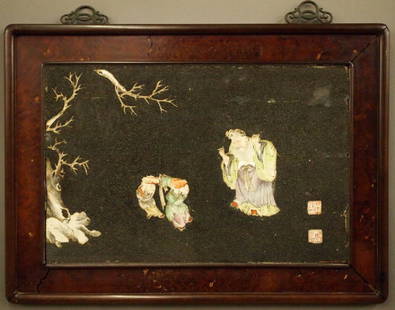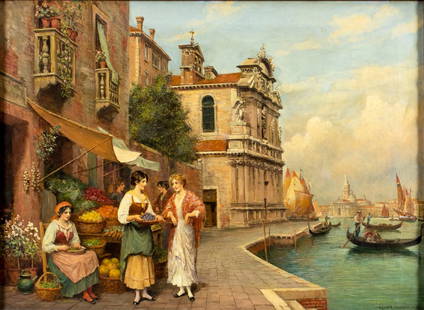
Vase of Sèvres. France, XVIII century. Hand painted porcelain and gilt bronze mount. With stamp on
Similar Sale History
View More Items in Paintings
Related Paintings
More Items in Paintings
View MoreRecommended Art
View More






Item Details
Description
Sèvres vase. France, 18th century.
Hand-painted porcelain and gilt bronze mount.
With stamp on the inside of the lid indicating that the date of production was around 1753.
Measurements: 48 x 25 x 19 cm.
Ornamental vase with bronze base and structure. It is decorated with pictorial scenes, the front with winged angels and the back with musical instruments, both delicately worked in its brushstrokes. Originally founded in Vincennes in 1740, the Manufacture Nationale de Sèvres was moved here in 1756. One of Europe's leading porcelain factories, the Manufacture was successively named after different political regimes: royal, imperial and national manufactory. Still active today, the firm continues to produce objects created since 1740, although its current production is largely oriented towards contemporary creation. The Manufacture de Vincennes was founded with the support of Louis XV and Madame de Pompadour, with the idea of creating pieces for the court and competing with the porcelain productions of Meissen and Chantilly. In fact, the first experiments were carried out by the brothers Robert and Gilles Dubois, who came from the Chantilly manufactory. By 1745, under the direction of the Gravant couple, important results had already been achieved, in particular the creation of models of porcelain flowers to decorate all kinds of pieces. The new building in Sèvres, where the manufactory moved in 1756, was built on the initiative of Madame de Pompadur. Three years later, it was designated a royal factory, and from that time onwards it was the only one in France to use fine gold. In its early years, the factory produced mainly soft paste; hard porcelain, with kaolin, was not marketed in Sèvres until 1770. Among the innovations of this manufactory in the 18th century were coloured backgrounds and the use of biscuit for small sculptures. During the French Revolution, the factory suffered a decline in production, but experienced a revival between 1800 and 1847 under the direction of Alexandre Brongniart, who brought the factory international fame. During these years, many important technical innovations were made, and a number of contemporary artists collaborated with the manufacture. During this period, a new gilding technique was introduced, which was made shiny by burnishing the surface with an agate stone. The pieces were also decorated with opaque gilding, which was done by rubbing the gold with very fine sand. It was at this time that, for ornamental vases, a cartouche became established as the central theme, in the manner of an oil painting, with a gilt cartouche on a monochrome background. From the mid-19th century onwards, the dominant styles were eclecticism and historicism, and some models revived typologies from the past, such as the Mannerism of Fontainebleau and the Baroque of Versailles.
Hand-painted porcelain and gilt bronze mount.
With stamp on the inside of the lid indicating that the date of production was around 1753.
Measurements: 48 x 25 x 19 cm.
Ornamental vase with bronze base and structure. It is decorated with pictorial scenes, the front with winged angels and the back with musical instruments, both delicately worked in its brushstrokes. Originally founded in Vincennes in 1740, the Manufacture Nationale de Sèvres was moved here in 1756. One of Europe's leading porcelain factories, the Manufacture was successively named after different political regimes: royal, imperial and national manufactory. Still active today, the firm continues to produce objects created since 1740, although its current production is largely oriented towards contemporary creation. The Manufacture de Vincennes was founded with the support of Louis XV and Madame de Pompadour, with the idea of creating pieces for the court and competing with the porcelain productions of Meissen and Chantilly. In fact, the first experiments were carried out by the brothers Robert and Gilles Dubois, who came from the Chantilly manufactory. By 1745, under the direction of the Gravant couple, important results had already been achieved, in particular the creation of models of porcelain flowers to decorate all kinds of pieces. The new building in Sèvres, where the manufactory moved in 1756, was built on the initiative of Madame de Pompadur. Three years later, it was designated a royal factory, and from that time onwards it was the only one in France to use fine gold. In its early years, the factory produced mainly soft paste; hard porcelain, with kaolin, was not marketed in Sèvres until 1770. Among the innovations of this manufactory in the 18th century were coloured backgrounds and the use of biscuit for small sculptures. During the French Revolution, the factory suffered a decline in production, but experienced a revival between 1800 and 1847 under the direction of Alexandre Brongniart, who brought the factory international fame. During these years, many important technical innovations were made, and a number of contemporary artists collaborated with the manufacture. During this period, a new gilding technique was introduced, which was made shiny by burnishing the surface with an agate stone. The pieces were also decorated with opaque gilding, which was done by rubbing the gold with very fine sand. It was at this time that, for ornamental vases, a cartouche became established as the central theme, in the manner of an oil painting, with a gilt cartouche on a monochrome background. From the mid-19th century onwards, the dominant styles were eclecticism and historicism, and some models revived typologies from the past, such as the Mannerism of Fontainebleau and the Baroque of Versailles.
Buyer's Premium
- 26%
Vase of Sèvres. France, XVIII century. Hand painted porcelain and gilt bronze mount. With stamp on
Estimate €1,500 - €1,600
7 bidders are watching this item.
Shipping & Pickup Options
Item located in Barcelona, -, esOffers In-House Shipping
Payment

TOP












































































